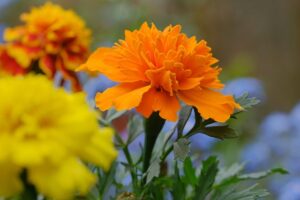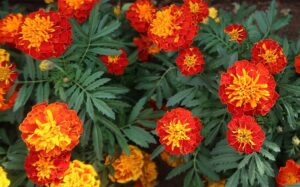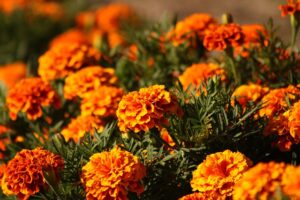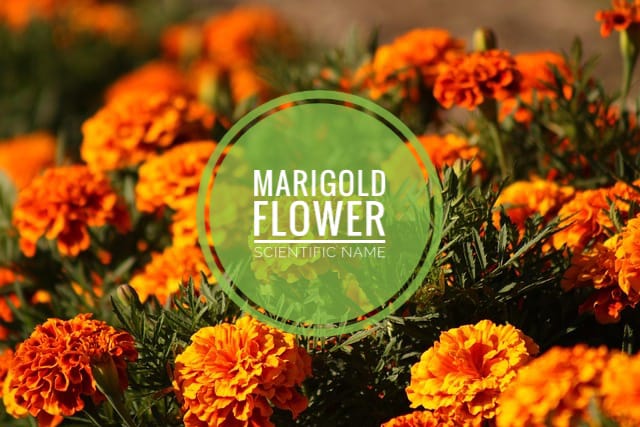Looking for a flower that is vibrant, easy to grow, and blooms almost endlessly? You’ve come to the right place.
Marigolds are one of the most loved garden flowers worldwide. They brighten spaces, repel pests and carry rich cultural value.
Whether you’re a beginner gardener or an experienced one, this guide covers everything you need about marigolds. From history and care to varieties and uses—you’ll find it all here.
Let’s start with a quick overview.
Marigold flowers pictures

| Attribute | Details |
|---|---|
| Common Name | Marigold |
| Botanical Name | Tagetes erecta, Tagetes patula, and other species |
| Family | Asteraceae (Daisy family) |
| Origin | Native to Mexico and Central America |
| Plant Type | Annual (some perennial species exist) |
| Growth Habit | Bushy, upright |
| Height | 6 inches to 3 feet (depending on type) |
| Lifespan | Single season (annual), reseeds easily |
| Special Feature | Pest-repelling, long blooming, drought-tolerant |
| Popular Use | Ornamental, religious offerings, garlands, companion planting |
History and Origin
The marigold traces its origin to Mexico and Central America, where it has grown naturally for centuries. Spanish explorers brought marigolds to Europe in the 16th century.
The botanical name Tagetes honors Tages, an Etruscan prophet linked to wisdom. The name “marigold” comes from “Mary’s Gold,” referencing its use in Christian offerings to the Virgin Mary.
In India, marigolds hold deep cultural significance. They are sacred flowers used in temples, weddings, and festivals like Diwali and Dussehra.
Across the world, marigolds symbolize sunlight, warmth, and positivity, often planted to brighten gardens and rituals alike.

Growing Conditions
Marigolds are famously low-maintenance and thrive in a variety of conditions.
Soil
They prefer moderately fertile, well-draining soil. Too much fertilizer makes them leafy but reduces blooms.
Water
Water regularly, keeping the soil evenly moist but never soggy. Once established, they handle short droughts well.
Sunlight
Full sunlight is best. Marigolds bloom more profusely in 6–8 hours of direct sunlight daily.
Temperature
They thrive in warm weather, ideally between 18°C to 30°C. They can’t handle frost, so plant after the last frost date.
Varieties of Marigold
There are many types of marigolds, each with unique beauty. Here are the main ones:
- African Marigold (Tagetes erecta)
- Tall plants with large, pom-pom blooms.
- Ideal for garlands and cut flowers.
- French Marigold (Tagetes patula)
- Compact plants with smaller, bicolored flowers.
- Great for borders and containers.
- Signet Marigold (Tagetes tenuifolia)
- Small, dainty flowers with edible petals.
- Leaves have a citrus-like scent.
- Triploid Hybrids
- Cross between African and French marigolds.
- Sterile but produce long-lasting blooms.
- Mexican Marigold (Tagetes lucida)
- Aromatic, herb-like plant used traditionally as a spice and for medicinal purposes.
With such variety, marigolds can fit every garden—small balconies, flower beds, or festive decorations.

Care Tips
Marigolds are easy-going, but a few care practices ensure abundant blooms.
Pruning
Deadhead spent flowers regularly. This encourages continuous blooming throughout the season.
Repotting
If growing in containers, repot yearly. Fresh soil helps maintain nutrient levels and plant vigor.
Fertilizing
Use balanced fertilizer sparingly. Too much nitrogen encourages leaves, not flowers. A monthly feed is sufficient.
Spacing
Plant African marigolds about 12–18 inches apart. French marigolds need 6–9 inches. Proper spacing prevents fungal problems.
Companion Planting
Plant marigolds with vegetables. They deter nematodes, whiteflies, and aphids naturally.
Read : Winter Flowers List India
Common Problems and Solutions
Marigolds are hardy, but not immune. Here’s what to watch out for:
- Powdery Mildew
- White coating on leaves.
- Solution: Improve air circulation and avoid overhead watering.
- Root Rot
- Caused by overwatering.
- Solution: Ensure well-drained soil.
- Spider Mites and Aphids
- Tiny insects that suck plant sap.
- Solution: Spray with neem oil or insecticidal soap.
- Botrytis Blight
- Gray mold on flowers and stems.
- Solution: Remove infected parts and keep the area dry.
- Leaf Yellowing
- Often due to poor soil drainage or lack of nutrients.
- Solution: Adjust soil and feed occasionally.

Uses and Benefits
Marigolds are more than garden beauties. They offer multiple benefits:
Ornamental
Bright, cheerful flowers add charm to gardens, balconies, and festivals.
Cultural and Religious
Widely used in garlands, pujas, and festivals like Diwali, weddings, and Día de los Muertos in Mexico.
Pest Control
Marigolds release chemicals that repel nematodes, mosquitoes, and garden pests.
Medicinal
Calendula (pot marigold, not a true Tagetes) is used in ointments for skin healing. Tagetes also has antibacterial properties.
Environmental
Attracts pollinators like bees and butterflies, improving overall garden health.
Interesting Facts
- Marigolds are often called “Herb of the Sun” for their vibrant golden blooms.
- They naturally deter mosquitoes and are often planted around homes.
- French marigolds are a favorite for companion planting with tomatoes.
- In Mexico, marigolds are central to Día de los Muertos celebrations, symbolizing remembrance.
- The petals of some species are edible and used to color food or in herbal teas.

FAQs
1. Do marigolds need full sun?
Yes, marigolds thrive in full sun. They can survive in partial shade but bloom less.
2. Can I grow marigolds in pots?
Absolutely. French marigolds are perfect for pots. Just use well-draining soil and ensure good sunlight.
3. How long do marigolds bloom?
They bloom from summer until frost, almost nonstop if deadheaded regularly.
4. Do marigolds repel pests naturally?
Yes, they deter nematodes, mosquitoes, and aphids, making them great for companion planting.
5. Are marigolds edible?
Some varieties, especially signet marigolds, have edible petals with a tangy flavor.
Conclusion
Marigolds are more than just garden flowers. They bring color, cultural richness, and even protection to your garden.
They are easy to grow, bloom endlessly, and have been loved across centuries. Whether in a garden bed, balcony pot, or festive garland, marigolds never disappoint.
Bring marigolds home, and let your garden shine with golden beauty season after season.

1 thought on “Marigold flowers pictures: A Complete Guide for Gardeners”